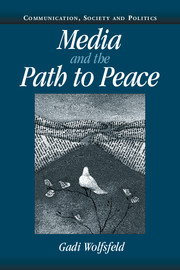Book contents
- Frontmatter
- Contents
- Acknowledgements
- Introduction
- 1 Building theory
- 2 The initial stages of Oslo
- 3 The Israeli media and the debate over Oslo
- 4 The Palestinians and the Israeli media
- 5 The media and the Israel–Jordan peace process
- 6 The media and the struggle for peace in Northern Ireland
- 7 The collapse of Oslo and the return to violence
- Conclusion
- Methodological appendix
- References
- Index
7 - The collapse of Oslo and the return to violence
Published online by Cambridge University Press: 22 September 2009
- Frontmatter
- Contents
- Acknowledgements
- Introduction
- 1 Building theory
- 2 The initial stages of Oslo
- 3 The Israeli media and the debate over Oslo
- 4 The Palestinians and the Israeli media
- 5 The media and the Israel–Jordan peace process
- 6 The media and the struggle for peace in Northern Ireland
- 7 The collapse of Oslo and the return to violence
- Conclusion
- Methodological appendix
- References
- Index
Summary
The summer and fall of 2000 will be remembered as a dreadful turning point in Middle East history. In July of that year President Clinton convened a summit at Camp David with Ehud Barak and Yasser Arafat with the goal of concluding a final settlement between the two sides. The talks ended in complete failure with each side blaming the other. Tensions continued to rise after the collapse, culminating in the outbreak of the Second Intifada in September of that year, bringing hundreds of deaths and thousands of wounded on both sides. Israelis and Palestinians who had hoped for an end to the conflict found the clock turned back to an era of hopelessness. The level of hate and anger between the two peoples reached new heights and those who had promoted the Oslo peace process looked, at best, fools.
The underlying logic of the Oslo process was that trust could be built in stages. Compromises that would have seemed impossible in 1993, it was thought, would become less difficult after the two sides had learned to cooperate. That is certainly not what happened. There was quite a bit of cooperation between the two sides and a certain amount of progress was made over the years. Nevertheless, each step towards a final settlement became increasingly painful and frustrating for both parties. Each accused the other of violating signed agreements and neither was convinced of the good intentions of the other.
- Type
- Chapter
- Information
- Media and the Path to Peace , pp. 182 - 219Publisher: Cambridge University PressPrint publication year: 2004



